Comparison of Different Negative-Sample Acquisition Strategies Considering Sample Representation Forms for Debris Flow Susceptibility Mapping
Abstract
1. Introduction
2. Materials and Methods
2.1. Study Area and Debris Flow Inventory
2.2. Sample Representation Forms and Conditioning Factors
2.2.1. Sample Representation Forms
2.2.2. Conditioning Factors
3. Methodology
3.1. Sampling and Partitioning Strategies
3.1.1. SVM
3.1.2. Spy Technique
3.1.3. IF
3.1.4. Cross-Validation
3.2. Information Gain Ratio
3.3. RF
3.4. ROC Curves
4. Results
4.1. Negative-Sample Acquisition Results
4.2. IGR of the Conditioning Factors
4.3. Comparison of Different Models
4.4. Debris Flow Susceptibility Maps
5. Discussion
5.1. Comparison of Different Sample Representation Forms
5.2. Comparison of Different Negative-Sample Acquisition Strategies
5.3. Limitations
6. Conclusions
- (1)
- Different sample representation forms have their own advantages and disadvantages. Watershed units have more obvious strengths in DFSM studies.
- (2)
- Different negative-sample acquisition strategies have different assumptions. The strategy based on the spy technique is less demanding and thus suitable for multiple datasets, while the IF-based strategy is well adapted to watershed unit datasets.
- (3)
- Watershed units with the negative-sample acquisition strategy based on the IF algorithm are the optimal combination in this study, with the most predictive conditioning factors, the best performing models, and the most plausible debris flow susceptibility maps.
Author Contributions
Funding
Data Availability Statement
Conflicts of Interest
References
- Tien Bui, D.; Shirzadi, A.; Shahabi, H.; Geertsema, M.; Omidvar, E.; Clague, J.J.; Thai Pham, B.; Dou, J.; Asl, D.T.; Bin Ahmad, B.; et al. New Ensemble Models for Shallow Landslide Susceptibility Modeling in a Semi-Arid Watershed. Forests 2019, 10, 743. [Google Scholar] [CrossRef]
- Huang, H.; Wang, Y.; Li, Y.; Zhou, Y.; Zeng, Z. Debris Flow Susceptibility Assessment in China: A Comparison between Traditional Statistical and Machine Learning Methods. Remote Sens. 2022, 14, 4475. [Google Scholar] [CrossRef]
- Pham, B.T.; Tien Bui, D.; Prakash, I.; Dholakia, M.B. Hybrid integration of Multilayer Perceptron Neural Networks and machine learning ensembles for landslide susceptibility assessment at Himalayan area (India) using GIS. Catena 2017, 149, 52–63. [Google Scholar] [CrossRef]
- Corominas, J.; Van Westen, C.; Frattini, P.; Cascini, L.; Malet, J.-P.; Fotopoulou, S.; Catani, F.; Van Den Eeckhaut, M.; Mavrouli, O.; Agliardi, F.; et al. Recommendations for the quantitative analysis of landslide risk. Bull. Eng. Geol. Environ. 2014, 73, 209–263. [Google Scholar] [CrossRef]
- Yao, X.; Tham, L.G.; Dai, F.C. Landslide susceptibility mapping based on support vector machine: A case study on natural slopes of Hong Kong, China. Geomorphology 2008, 101, 572–582. [Google Scholar] [CrossRef]
- Tunusluoglu, M.C.; Gokceoglu, C.; Sonmez, H.; Nefeslioglu, H.A. An artificial neural network application to produce debris source areas of Barla, Besparmak, and Kapi Mountains (NW Taurids, Turkey). Nat. Hazards Earth Syst. Sci. 2007, 7, 557–570. [Google Scholar] [CrossRef][Green Version]
- Hong, H.; Pradhan, B.; Jebur, M.N.; Bui, D.T.; Xu, C.; Akgun, A. Spatial prediction of landslide hazard at the Luxi area (China) using support vector machines. Environ. Earth Sci. 2016, 75, 40. [Google Scholar] [CrossRef]
- Chen, W.; Xie, X.; Peng, J.; Wang, J.; Duan, Z.; Hong, H. GIS-based landslide susceptibility modelling: A comparative assessment of kernel logistic regression, Naive-Bayes tree, and alternating decision tree models. Geomat. Nat. Hazards Risk 2017, 8, 950–973. [Google Scholar] [CrossRef]
- Liang, Z.; Wang, C.; Duan, Z.; Liu, H.; Liu, X.; Khan, K.U.J. A Hybrid Model Consisting of Supervised and Unsupervised Learning for Landslide Susceptibility Mapping. Remote Sens. 2021, 13, 1464. [Google Scholar] [CrossRef]
- Trigila, A.; Iadanza, C.; Esposito, C.; Scarascia-Mugnozza, G. Comparison of Logistic Regression and Random Forests tech-niques for shallow landslide susceptibility assessment in Giampilieri (NE Sicily, Italy). Geomorphology 2015, 249, 119–136. [Google Scholar] [CrossRef]
- Pham, B.T.; Nguyen-Thoi, T.; Qi, C.; Van Phong, T.; Dou, J.; Ho, L.S.; Van Le, H.; Prakash, I. Coupling RBF neural network with ensemble learning techniques for landslide susceptibility mapping. Catena 2020, 195, 104805. [Google Scholar] [CrossRef]
- Youssef, A.M.; Pourghasemi, H.R. Landslide susceptibility mapping using machine learning algorithms and comparison of their performance at Abha Basin, Asir Region, Saudi Arabia. Geosci. Front. 2021, 12, 639–655. [Google Scholar] [CrossRef]
- Hong, H.; Pourghasemi, H.R.; Pourtaghi, Z.S. Landslide susceptibility assessment in Lianhua County (China): A comparison between a random forest data mining technique and bivariate and multivariate statistical models. Geomorphology 2016, 259, 105–118. [Google Scholar] [CrossRef]
- Zhu, A.-X.; Miao, Y.; Liu, J.; Bai, S.; Zeng, C.; Ma, T.; Hong, H. A Similarity-based Approach to Sampling Absence Data for Landslide Susceptibility Mapping Using Data-driven Methods. Catena 2019, 183, 104188. [Google Scholar] [CrossRef]
- Fu, X.; Liu, Y.; Zhu, Q.; Ge, D.; Li, Y.; Zeng, H. Reliable assessment approach of landslide susceptibility in broad areas based on optimal slope units and negative samples involving priori knowledge. Int. J. Digit. Earth 2022, 15, 2495–2510. [Google Scholar] [CrossRef]
- Xiao, T.; Yin, K.; Yao, T.; Liu, S. Spatial prediction of landslide susceptibility using GIS-based statistical and machine learning models in Wanzhou County, Three Gorges Reservoir, China. Acta Geochim. 2019, 5, 654–669. [Google Scholar] [CrossRef]
- Gao, R.; Wang, C.; Han, S.; Liu, H.; Liu, X.; Wu, D. A Research on Cross-Regional Debris Flow Susceptibility Mapping Based on Transfer Learning. Remote Sens. 2022, 14, 4829. [Google Scholar] [CrossRef]
- Gao, R.-Y.; Wang, C.-M.; Liang, Z. Comparison of different sampling strategies for debris flow susceptibility mapping: A case study using the centroids of the scarp area, flowing area and accumulation area of debris flow watersheds. J. Mt. Sci. 2021, 18, 1476–1488. [Google Scholar] [CrossRef]
- Yu, B.; Li, L.; Wu, Y.; Chu, S. A formation model for debris flows in the Chenyulan River Watershed, Taiwan. Nat. Hazards 2013, 68, 745–762. [Google Scholar] [CrossRef]
- Reichenbach, P.; Rossi, M.; Malamud, B.D.; Mihir, M.; Guzzetti, F. A review of statistically-based landslide susceptibility models. Earth Sci. Rev. 2018, 180, 60–91. [Google Scholar] [CrossRef]
- Zhao, Y.; Meng, X.; Qi, T.; Chen, G.; Li, Y.; Yue, D.; Qing, F. Extracting more features from rainfall data to analyze the conditions triggering debris flows. Landslides 2022, 19, 2091–2099. [Google Scholar] [CrossRef]
- Hong, H.; Pradhan, B.; Xu, C.; Bui, D.T. Spatial prediction of landslide hazard at the Yihuang area (China) using two-class kernel logistic regression, alternating decision tree and support vector machines. Catena 2015, 133, 266–281. [Google Scholar] [CrossRef]
- Oh, H.-J.; Pradhan, B. Application of a neuro-fuzzy model to landslide-susceptibility mapping for shallow landslides in a tropical hilly area. Comput. Geosci. 2011, 37, 1264–1276. [Google Scholar] [CrossRef]
- Pourghasemi, H.R.; Jirandeh, A.G.; Pradhan, B.; Xu, C.; Gokceoglu, C. Landslide susceptibility mapping using support vector machine and GIS at the Golestan Province, Iran. J. Earth Syst. Sci. 2013, 122, 349–369. [Google Scholar] [CrossRef]
- Meng, Z.; Lyu, L.; Xu, M.; Yu, G.; Ma, C.; Wang, Z.; Stoffel, M. Effects of frequent debris flows on barrier lake formation, sedimentation and vegetation disturbance, Palongzangbo River, Tibetan Plateau. Catena 2023, 220, 106697. [Google Scholar] [CrossRef]
- Gao, R.; Wang, C.; Liang, Z.; Han, S.; Li, B. A Research on Susceptibility Mapping of Multiple Geological Hazards in Yanzi River Basin, China. ISPRS Int. J. Geo-Inf. 2021, 10, 218. [Google Scholar] [CrossRef]
- Li, X.Z.; Kong, J.M. Application of Support Vector Machine with Posterior Probability Estimates in Debris Flow Hazard Assessment. Disaster Adv. 2011, 4, 38–44. [Google Scholar]
- Bekker, J.; Davis, J. Learning from positive and unlabeled data: A survey. Mach. Learn. 2020, 109, 719–760. [Google Scholar] [CrossRef]
- Tan, X.; Yang, J.; Rahardja, S. Sparse random projection isolation forest for outlier detection. Pattern Recognit. Lett. 2022, 163, 65–73. [Google Scholar] [CrossRef]
- Krkač, M.; Gazibara, S.B.; Arbanas, Ž.; Sečanj, M.; Arbanas, S.M. A comparative study of random forests and multiple linear regression in the prediction of landslide velocity. Landslides 2020, 17, 2515–2531. [Google Scholar] [CrossRef]
- Pontius, R.G.; Parmentier, B. Recommendations for using the relative operating characteristic (ROC). Landsc. Ecol. 2014, 29, 367–382. [Google Scholar] [CrossRef]
- Wang, H.; Zhang, L.; Yin, K.; Luo, H.; Li, J. Landslide identification using machine learning. Geosci. Front. 2021, 12, 351–364. [Google Scholar] [CrossRef]
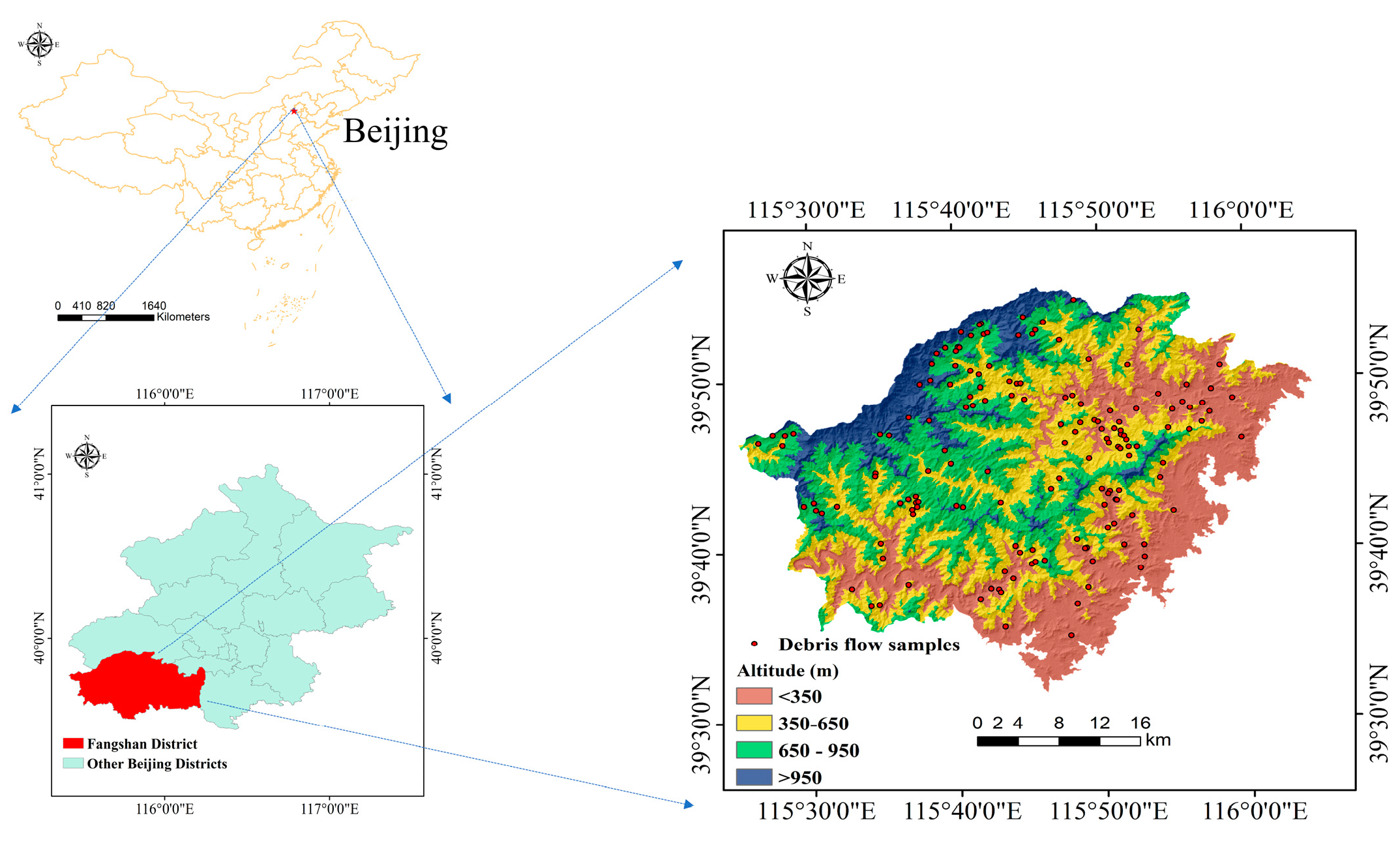


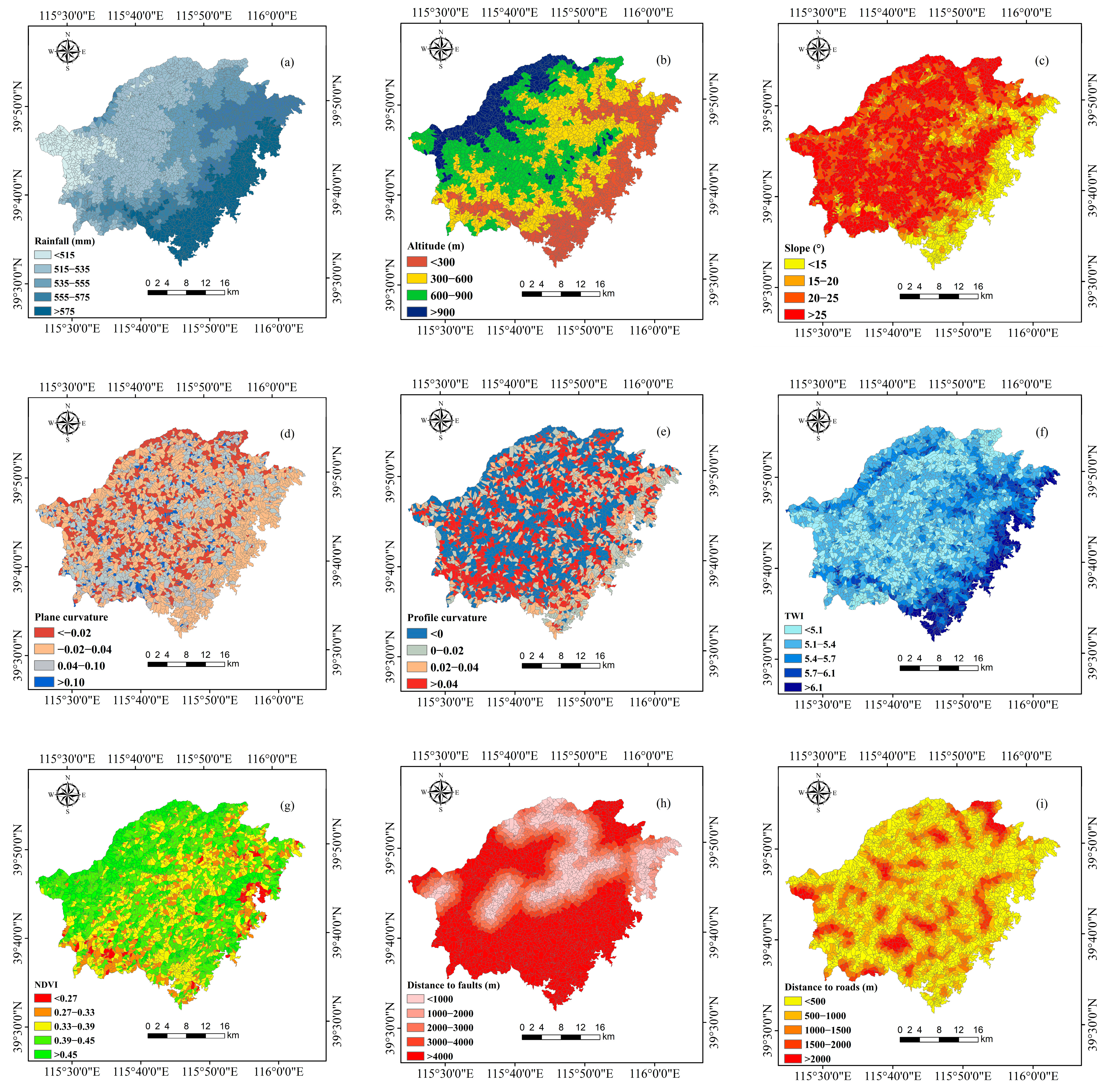

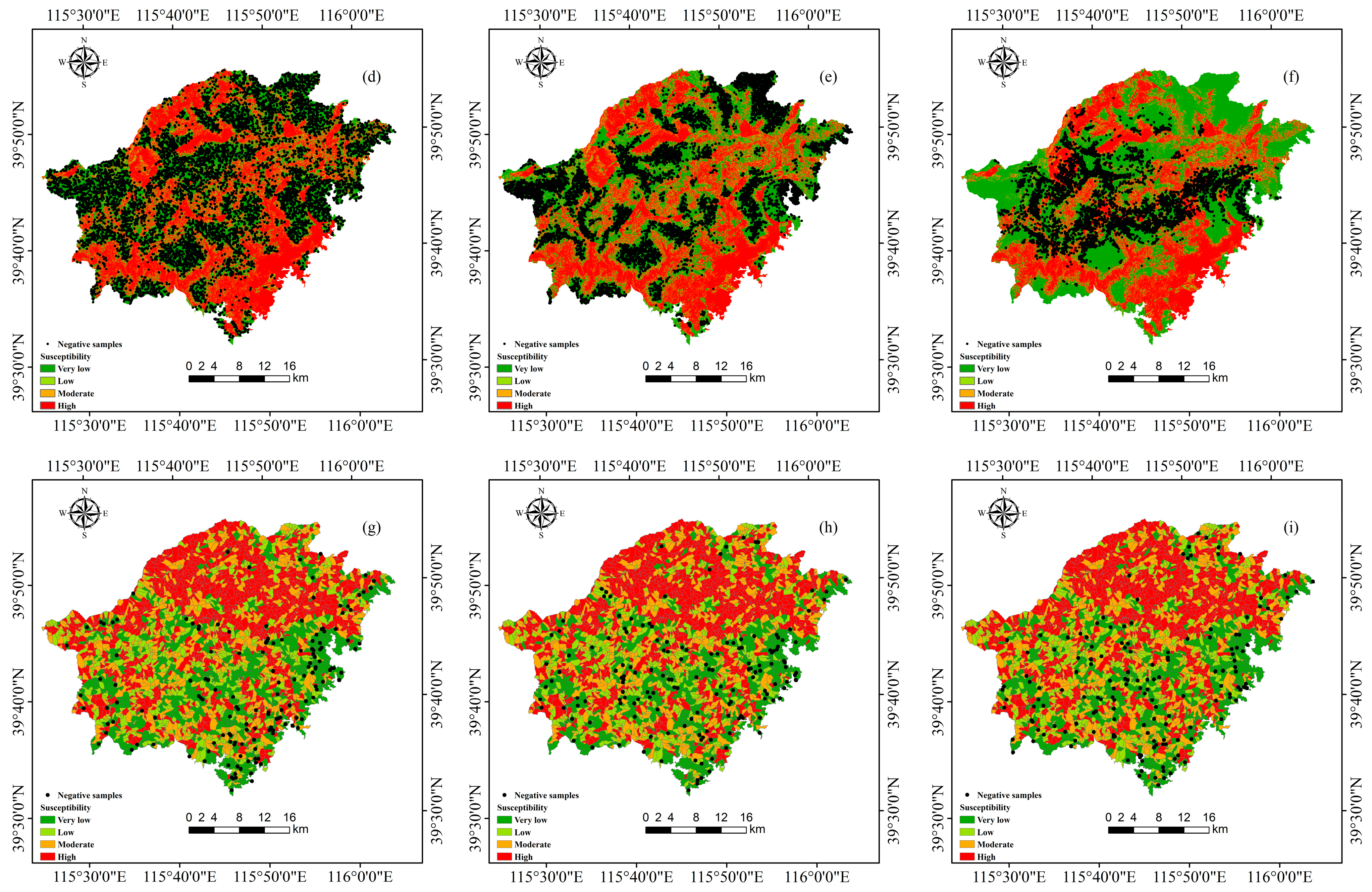
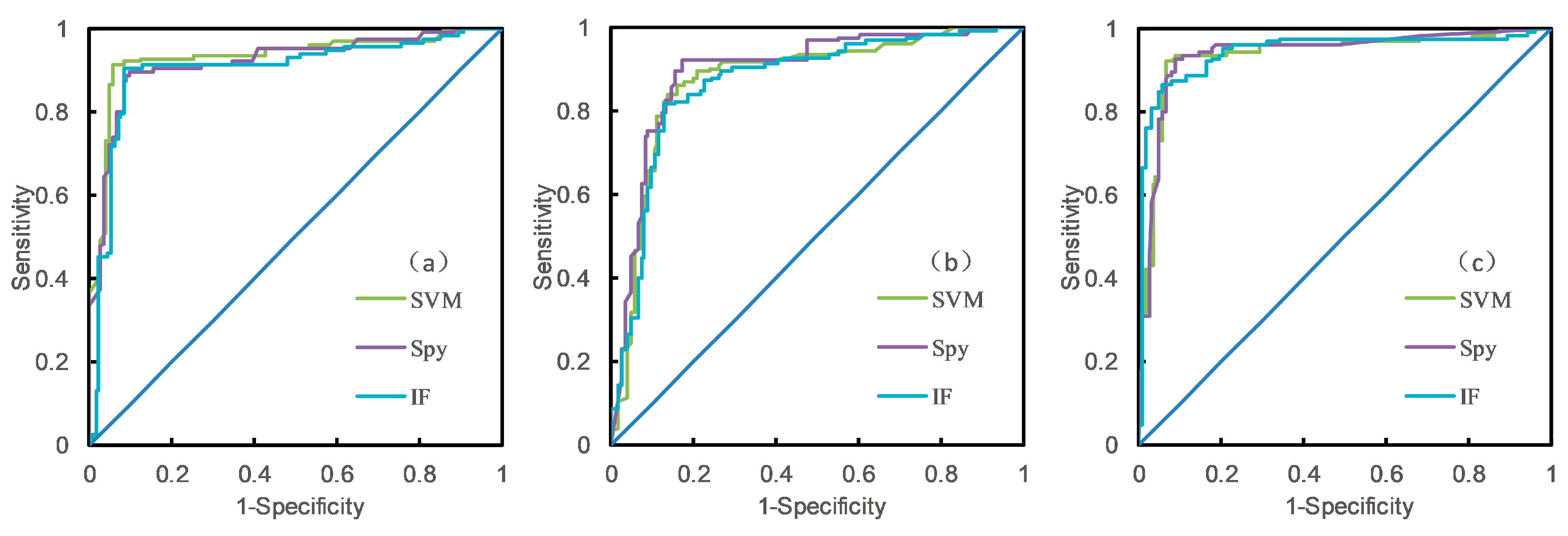
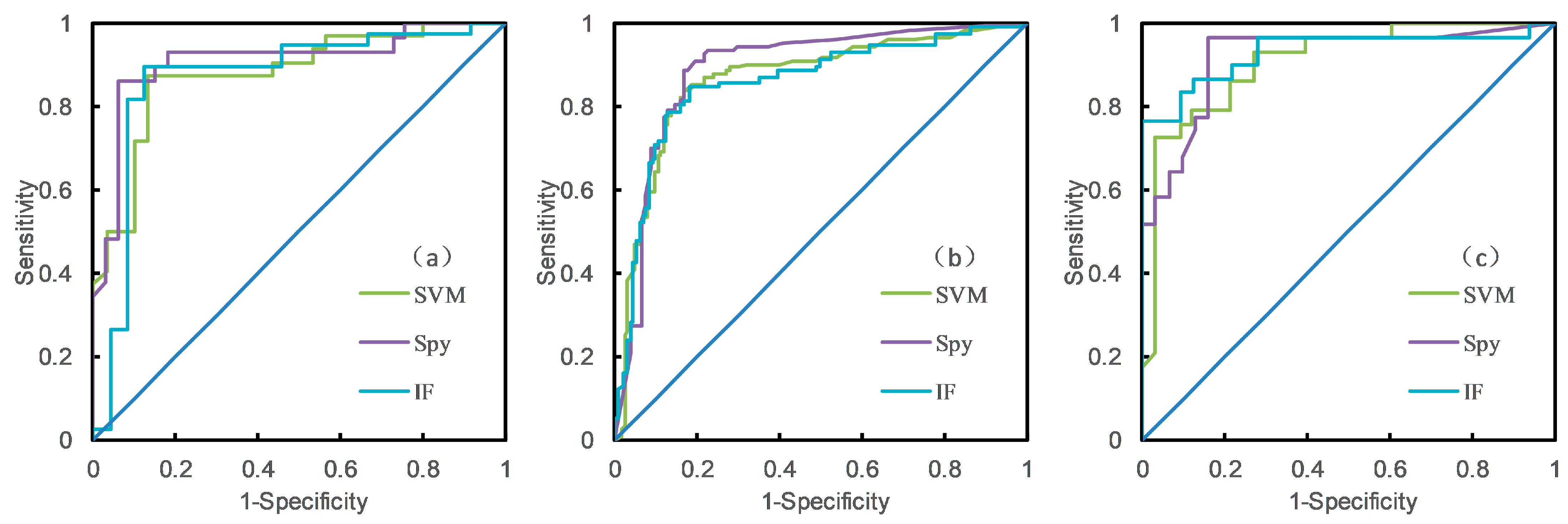

| Representation Forms | Conditioning Factors | SVM-Based | Spy-Based | IF-Based |
|---|---|---|---|---|
| Single grid | Rainfall | 0.092661 | 0.096309 | 0.035283 |
| Altitude | 0.064700 | 0.072970 | 0.044267 | |
| Slope | 0.052486 | 0.164884 | 0.050151 | |
| Plane curvature | 0.009772 | 0.011732 | 0.002229 | |
| Profile curvature | 0.007298 | 0.010095 | 0.003221 | |
| TWI | 0.102360 | 0.221782 | 0.021809 | |
| NDVI | 0.029817 | 0.030426 | 0.011323 | |
| DTF | 0.021958 | 0.069592 | 0.014625 | |
| DTR | 0.188112 | 0.217063 | 0.172086 | |
| Multi-grid | Rainfall | 0.027362 | 0.073548 | 0.014158 |
| Altitude | 0.036237 | 0.061468 | 0.013859 | |
| Slope | 0.011209 | 0.033521 | 0.006381 | |
| Plane curvature | 0.003544 | 0.003607 | 0.001564 | |
| Profile curvature | 0.005132 | 0.008222 | 0.002221 | |
| TWI | 0.002520 | 0.004043 | 0.000903 | |
| NDVI | 0.004635 | 0.027623 | 0.001348 | |
| DTF | 0.018008 | 0.068456 | 0.010054 | |
| DTR | 0.203351 | 0.228164 | 0.134484 | |
| Watershed unit | Rainfall | 0.051102 | 0.067690 | 0.069879 |
| Altitude | 0.054035 | 0.066648 | 0.079492 | |
| Slope | 0.046257 | 0.067201 | 0.077270 | |
| Plane curvature | 0.084715 | 0.103792 | 0.164850 | |
| Profile curvature | 0.097196 | 0.114082 | 0.164520 | |
| TWI | 0.040089 | 0.057586 | 0.070916 | |
| NDVI | 0.01849 | 0.027924 | 0.037865 | |
| DTF | 0.031382 | 0.042168 | 0.048835 | |
| DTR | 0.099004 | 0.173459 | 0.215150 |
| Sample Representation Form | SVM-Based | Spy-Based | IF-Based |
|---|---|---|---|
| Single grid | 0.919 | 0.932 | 0.902 |
| Multi-grid | 0.876 | 0.895 | 0.869 |
| Watershed unit | 0.937 | 0.939 | 0.946 |
| Sample Representation Form | SVM-Based | Spy-Based | IF-Based |
|---|---|---|---|
| Single grid | 0.881 | 0.911 | 0.868 |
| Multi-grid | 0.866 | 0.888 | 0.856 |
| Watershed unit | 0.909 | 0.920 | 0.932 |
| Sample Representation Form | Susceptibility | Percentage | No. of Debris Flow Samples | Percentage of Debris Flow Samples (%) |
|---|---|---|---|---|
| Single grid | Low | 29.5 | 4 | 2.6 |
| Moderate | 15.1 | 8 | 5.2 | |
| High | 12.6 | 20 | 12.9 | |
| Very high | 42.8 | 123 | 79.3 | |
| Multi-grid | Low | 35.8 | 9 | 5.8 |
| Moderate | 9.2 | 15 | 9.7 | |
| High | 10.2 | 26 | 16.8 | |
| Very high | 44.8 | 105 | 67.7 | |
| Watershed unit | Low | 31.0 | 3 | 1.9 |
| Moderate | 13.2 | 5 | 3.3 | |
| High | 20.1 | 34 | 21.9 | |
| Very high | 35.7 | 113 | 72.9 |
Disclaimer/Publisher’s Note: The statements, opinions and data contained in all publications are solely those of the individual author(s) and contributor(s) and not of MDPI and/or the editor(s). MDPI and/or the editor(s) disclaim responsibility for any injury to people or property resulting from any ideas, methods, instructions or products referred to in the content. |
© 2024 by the authors. Licensee MDPI, Basel, Switzerland. This article is an open access article distributed under the terms and conditions of the Creative Commons Attribution (CC BY) license (https://creativecommons.org/licenses/by/4.0/).
Share and Cite
Gao, R.; Wu, D.; Liu, H.; Liu, X. Comparison of Different Negative-Sample Acquisition Strategies Considering Sample Representation Forms for Debris Flow Susceptibility Mapping. Appl. Sci. 2024, 14, 9240. https://doi.org/10.3390/app14209240
Gao R, Wu D, Liu H, Liu X. Comparison of Different Negative-Sample Acquisition Strategies Considering Sample Representation Forms for Debris Flow Susceptibility Mapping. Applied Sciences. 2024; 14(20):9240. https://doi.org/10.3390/app14209240
Chicago/Turabian StyleGao, Ruiyuan, Di Wu, Hailiang Liu, and Xiaoyang Liu. 2024. "Comparison of Different Negative-Sample Acquisition Strategies Considering Sample Representation Forms for Debris Flow Susceptibility Mapping" Applied Sciences 14, no. 20: 9240. https://doi.org/10.3390/app14209240
APA StyleGao, R., Wu, D., Liu, H., & Liu, X. (2024). Comparison of Different Negative-Sample Acquisition Strategies Considering Sample Representation Forms for Debris Flow Susceptibility Mapping. Applied Sciences, 14(20), 9240. https://doi.org/10.3390/app14209240





